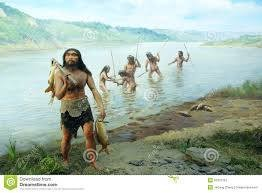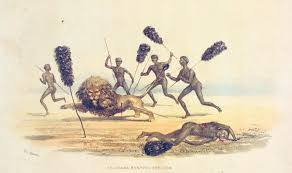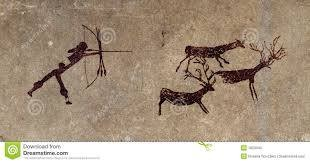"பழைய கற்கால உணவு பழக்கங்கள் தொடர்கிறது"
"FOOD HABITS OF TAMILS" PART / /
"FOOD HABITS OF PALEOLITHIC PERIOD CONTINUING" [ஆங்கிலத்திலும் தமிழிலும் / In English and
Tamil]
இன்றில் இருந்து, 2.5 மில்லியன் ஆண்டுகளுக்கும் 10,000 ஆண்டுகளுக்கும் இடைப்பட்ட பழைய கற்காலத்தில் அதாவது விவசாயத்திற்கும் கைத்தொழிலிற்கும் முற்பட்ட காலத்தில், மனித இனம் பொதுவாக வேட்டையாடுபவராகவும்,உணவு சேகரிப்போராகவும், ஒரு நாடோடி வாழ்க்கை முறையைக் மேற்கொண்டனர். கனிகள், காய்கள், கிழங்குகள் மற்றும் விலங்குகளின் இறைச்சிகள் இவர்களது முக்கிய உணவுப் பொருள்களாகும். பாலூட்டிகளை சோர்வடையும் வரை துரத்தினார்கள். பெரிய சூறையாடும் [மற்றப் பிராணிகளைத் தின்கிற] விலங்குகள் விட்டுச் சென்ற பிராணிகளின் இறைச்சி, கொழுப்பு, உறுப்பு போன்ற அழுகு ஊன்களை உண்டார்கள். என்றாலும் ஒருவாறு இறுதியில், அவர்கள் மீனைத் தூண்டில் போட்டு பிடிக்கவும் ஈட்டி, வலை, அம்பு, வில்லு போன்றவை கொண்டு வேட்டையாடவும் கற்றுக் கொண்டனர். மனிதனின் பரிணாம வளர்ச்சியில் உணவு முக்கிய இடத்தை பெறுகிறது. இது பல மாற்றங்கள் பெற்று, எமது முன்னோரில் இருந்து வழிவழியாக எமக்கு வந்துள்ளது. இன்று நாம், சிறந்த உணவை எமக்கு தேர்ந்து எடுப்பதற்கு, எப்படி நாம் பரிணாம வளர்ச்சி பெற்றோம் என்பதை விளங்கிக் கொள்வது கட்டாயம் உதவி புரியும்.
இன்று ஒவ்வொரு உயிர் இனமும் பொதுவாக சாப்பிடும் உணவு - அது பழமாகவோ, காய்கறியாகவோ அல்லது விலங்காகவோ அது எப்படி இருப்பினும் - அவை, அவைகளின் பழைய கற்கால முன்னோர்களின் உணவு பழக்கத்தில் இருந்து முற்றிலும் வேறுபட்டது. பெரும்பாலான சந்தர்ப்பங்களில், நாம் சாப்பிடும் தாவர, விலங்கு வகைகள் செயற்கைத் தேர்வு மூலம் மாற்றப்பட்டது. இன்று, முடிந்த அளவுக்கு இறைச்சி, பால், முட்டை முதலியவற்றைக் கூடுதலாக பெறக் கூடியதாக நாம் மாடு, கோழி, ஆடு போன்றவற்றை தேர்ந்து எடுத்து வளர்ப்பதுடன் பெரிய பழங்கள், மென்மையான, பொதுவாக உண்ணக்கூடிய கொழுப்பான கொட்டைகள், விதைகள் போன்றவற்றை அதன் ஓடுக்குள், நடுப்பகுதியில் கொண்ட பழங்கள், இனிமையான சதையையும் குறைந்த இயற்கையான நச்சுகளையும் கொண்ட பழங்கள் அல்லது காய்கறிகள் [biggest fruits,
plumpest kernels, sweetest flesh and fewest natural toxins] போன்ற விரும்பத் தகுந்த தன்மைகளைக் கொண்ட விதைகளை தேர்ந்து எடுத்தும் நாம் விதைக்கிறோம்.
எமது முன்னோர்கள் ஒரு நாளைக்கு எத்தனைத் தடவை உணவு உட்கொண்டார்கள் என்பது எமக்கு சரியாகத் தெரியா விட்டாலும், இன்று போல் அன்று மூன்று வேளை உணவு கட்டாயம் அவர்கள் உட்கொண்டிருக்க மாட்டார்கள் என்பது புரிகிறது. அன்றைய சூழ்நிலையில், அதிகமாக தமது பெரும்பாலான உணவை பிற்பகலில் அல்லது மாலையில் உண்டார்கள் என நாம் ஓரளவு சரியாக ஊகிக்க கூடியதாக உள்ளது. வேட்டையாட விலங்கு ஒன்று கிடைக்க வேண்டும், பின் அதை வேட்டையாடி கொல்ல வேண்டும். துண்டுகளாக வெட்டி, அதிகமாக சமைக்க வேண்டும். அதே போல கிழங்குகளும் காய் கறிகளும் கண்டுபிடிக்க வேண்டும், அதன் பின் தோண்ட வேண்டும் அல்லது பறித்து எடுக்கவேண்டும், இறுதியாக அவைகளை சாப்பிடக் கூடியதாக தயார் செய்ய வேண்டும். ஆகவே ஏதாவது காலை உணவு இந்த வேட்டையாடு பவர்களாலும், உணவு சேகரிப்போராலும் சாப்பிடப் பட்டது என்றால் அது கட்டாயம் முன்னைய இரவின் மிச்சமாகவே இருக்க வேண்டும். அவர்கள் எவ்வளவு, எந்தெந்த நேரம் சாப்பிட்டார்கள் என்பது ஒருவருக்கும் தெரியாது. என்றாலும் ஒன்று மட்டும் நன்றாகத் ஊகிக்க முடிகிறது. அவர்கள் வளர்ப்பு பிராணிகள் அல்லது முன்பு அறுவடை செய்த தானியங்கள், கிழங்குகள் வைத்து இருந்தாலொழிய மற்றும்படி, நித்திரையால் எழும்பியதும் உடனடியாக சாப்பிட அவர்களால் முடியாது. ஆகவே எமது முன்னைய வேட்டையாடு பவர்களாலும், உணவு சேகரிப்போராலும் அதிகமாக காலை உணவு சாப்பிட சந்தர்ப்பம் மிக மிக குறைவாகவே இருந்து இருக்கும்.
மேலும் இந்த சாவகாசமான வேட்டையாடுபவரினதும், உணவு சேகரிப்போரினதும் வாழ்வை விட விவசாயம் கடும் உழைப்பை கொண்டது. அது மட்டும் அல்ல, சேவல் கூவலுடன் அதி காலை தொடங்குகிறது. ஆகவே தமது நீண்ட கடும் வேலையை தொடங்கும் முன்பு, எமது முன்னைய விவசாயிகள் தம்மை பலப்படுத்த ஏதாவது ஒன்றை - தம்மிடம் உள்ளதைக் கட்டாயம் உண்டிருப்பார்கள் என நாம் நம்பலாம். மேலும் இது ஆச்சரியப் படகூடிய ஊகமும் அல்ல.
பொதுவாக ஒரு நாளில் மூன்று முறை உணவு உட்கொள்ளுதல் இயல்பான ஒன்று என்ற எண்ணம் எம்மிடம் இன்று உள்ளது. ஆனால் அப்படி என்றும் இருக்கவில்லை. இது இன்றைய பண்பாட்டில் ஏற்பட்ட ஒரு நடை முறையே ஆகும். உலகத்தில் உள்ள எல்லா மக்களும் - மேற்கு நாடு உட்பட - அனைவரும் என்றும் மூன்று முறை உணவு உட்கொள்ள வில்லை. பல ஆயிரம் ஆண்டுகளுக்கு மேலாக ஒரு வேளை உணவு முறையே வழக்கத்தில் இருந்ததாக BBC யின் "history of breakfast, lunch and dinner." என்ற கட்டுரை ஒன்றும் கூறுகிறது. நாம் இன்று கேள்விப்படும் காலை உணவு முறை மனித வரலாற்றின் பெரும் பகுதியில் காணப் படவில்லை. ரோமர்கள் அப்படி ஒன்றை உண்ணவில்லை. அவர்கள் பொதுவாக ஒரு உணவையே மதியம் வேளை உண்டார்கள் என உணவு வரலாற்றாளர் கரோலின் யெல்தம் [Caroline Yeldham ]
கூறுகிறார்.
பண்டையக்கால சரித்திரத்தை புரட்டி பார்த்தோம் என்றால், அதில் கிரேக்கர்கள் மற்றும் ரோமர்களின் வரலாற்று நிகழ்வுகள் பெரும் பகுதியாக நிறைந் திருக்கும். அப்படி பெருமைப் படத்தக்க கல்வி, தடகள கலாச்சாரங்களை [academic and
athletic cultures] கொண்ட இந்த மக்கள் ஒரு சமைத்த பெரிய விருந்தாக - முதன்மை உணவாக - ஒரு நேரம் - அதிகமாக, பின்னேரம் அல்லது பிற்பகலில் உட்கொண்டார்கள். ஆகவே, அதிகமாக அவர்கள் இரண்டு உணவு உட்கொண்டார்கள் என நாம் ஊகிக்கலாம். அவர்கள் அதிகமாக, இந்த முதன்மை உணவிற்கு முன் ஒரு சிறிய உணவு எதோ ஒரு நேரத்தில் எடுத்து இருக்கலாம். "To rise at
six, dine at ten, sup at six and go to bed at ten, makes a man live ten times
ten." / "காலை ஆறுக்கு துயில் எழுந்து, பத்துக்கு [உணவை] உண்டு ,பின் ஆறுக்கு [இரா உணவை] உண்டு, பத்துக்கு [நித்திரைக்கு] கட்டிலுக்கு போய், வாழ்வை பத்து மடங்கு பத்தாக உயர்த்துவோம்" என்ற பதினாறாம் நுற்றாண்டு பழமொழி ஒன்று என் நினைவுக்கு வருகிறது. எனவே மூன்று முறை உணவு என்ற கருத்து மிக அண்மையானதே. முன்னைய எமது முதாதையர்கள் அதிகமாக இரு முறையே உட் கொண்டிருப்பார்கள். சூரிய உதயத்திற்கு சற்றுப் பின்பும் சூரிய மறைவிற்கு சற்று முன்பும் ஆகும். இரவு உணவு முறை, அதிகமாக மின்சாரம் கண்டு பிடிக்கப்பட்ட பின் வந்து இருக்கலாம். நாம், வரலாற்றில் வளர்ச்சி அடைந்து கொண்டு போகையில், எமது நட வடிக்கையும் நீண்டு பிற்பகலின் பிற்பகுதி மட்டும் சென்றது. ஆகவே அவர்களுக்கு தமது உணவை அதற்குத் தக்கதாக பரப்ப அல்லது நீட்ட வேண்டி இருந்தது.
நன்றி
[கந்தையா தில்லைவிநாயகலிங்கம், அத்தியடி, யாழ்ப்பாணம்]
பகுதி : 07 தொடரும்
👉ஆரம்பத்திலிருந்து வாசிக்க...
Theebam.com: "தமிழரின் உணவு பழக்கங்கள்"பகுதி: 01:
FOOD HABITS OF
TAMILS / PART 06
"FOOD HABITS OF
PALEOLITHIC PERIOD-CONTINUING"
Our ancestors in the Palaeolithic period, between 2.5 million and
10,000 years ago and before agriculture and industry, lived as hunter -
gatherers : picking berry after berry off of bushes; digging up tumescent
tubers; chasing mammals to the point of exhaustion; scavenging meat, fat and
organs from animals that larger predators had killed; and eventually learning
to fish with lines and hooks and hunt with spears, nets, bows and arrows. Diet
has been an important part of our evolution - as it is for every species - and
we have inherited many adaptations from our Paleo predecessors. Understanding
how we evolved could, in principle, help us make smarter dietary choices today.
Every single species commonly consumed today - whether a fruit, vegetable or
animal - is drastically different from its Palaeolithic predecessor. In most
cases, we have transformed the species we eat through artificial selection: we
have bred cows, chickens and goats to provide as much meat, milk and eggs as
possible and have sown seeds only from plants with the most desirable traits -
with the biggest fruits, plumpest kernels, sweetest flesh and fewest natural
toxins.
it’s a reasonable assumption that our ancestors ate most of their food
in the afternoon or evening. For example, Game had to be found, hunted, killed,
butchered, and usually cooked. Tubers and vegetables had to be found, dug,
gathered and prepared. So any “breakfast” eaten by hunter - gatherers would
most likely have been leftovers from the night before - if they were lucky
enough to have any. No one knows the exact timing and size of meals in different
agricultural societies throughout history and I don’t put much stock in what
passes for historical accounts, but it’s clear that we’re not going to reliably
have food to eat soon after awakening unless we’ve got domesticated animals, or
a storehouse of previously harvested and prepared grains or tubers. As opposed
to the leisurely life of hunter-gatherers, which usually involves dramatically
less work than ours farming is labor - intensive, and it usually starts at dawn
with the rooster - so it’s not surprising that people would want to fuel up
before beginning a long day of hard work. Historically, farmers seem to have
eaten whatever food they had available. Hunter-gatherers most likely ate
breakfast infrequently, if at all. When they did, it was leftovers.
Have been brought up on the idea of three square meals a day as a
normal eating pattern, but it wasn't always that way. We grew up believing in
three meals a day. But it's a cultural construct. People around the world, even
in the West have not always eaten three squares. The three - meals model is a
fairly recent convention, For more than a thousand years the one-meal system
was the rule from a great BBC article on the history of breakfast, lunch and
dinner. Breakfast as we know it didn’t exist for large parts of history. The
Romans didn’t really eat it, usually consuming only one meal a day around noon,
says food historian Caroline Yeldham. So in the history of some of the greatest
academic and athletic cultures, they ate but only one “main” meal per day! In
terms of “meal” in the quotes above, this was most likely referring to their
larger “cooked” feast later in the day. It was more like 2 meals. The later
meal being the main and larger one, but they most likely also had an earlier
smaller “meal” at some point. For me …. I like this old 16th century proverb to
sum it all up: "To rise at six, dine at ten, sup at six and go to bed at
ten, makes a man live ten times ten". I think the concept of 3 meals a day
is very recent. Early humans probably had 2 meals a day-just after sunrise and
just before sunset. 2 meals probably made more sense as it synchronised with
day and night. The concept of a night - time meal is probably after the
invention of electricity. As we evolved, we started doing more activities that
stretched into the later part of the evening - so probably needed to spread out
our meals.
Thanks
[Kandiah
Thillaivinayagalingam,Athiady, Jaffna]
PART : 07 WILL
FOLLOW





No comments:
Post a Comment